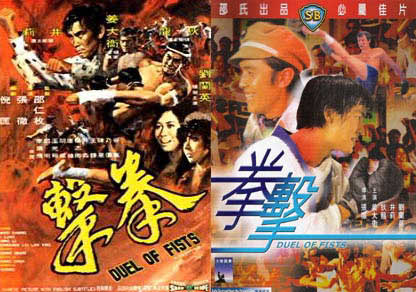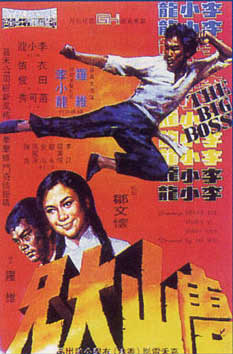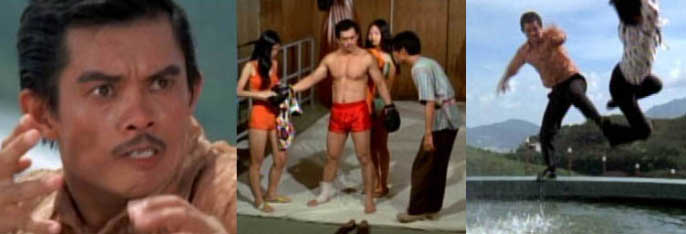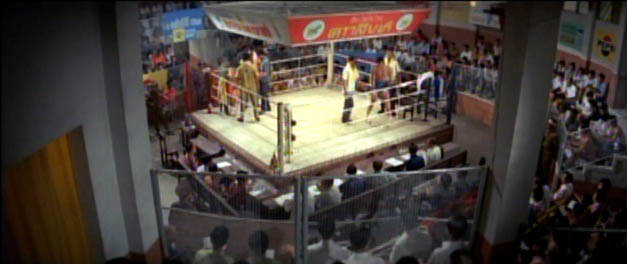
Reviewed by Yves Gendron

On October first 1971, the Hong-Kong viewing audience received quite a wallop coming from the newly released DUEL OF FISTS, an early kung-fu film centred on the fierce and gruelling brand of Thai boxing known as Muay Thai. The film was the latest of master martial filmmaker Chang Cheh’s ongoing Blood Brother cycle of movies; action packed and typically gloomy martial-art tragedies pairing together the majestic, brooding Ti Lung with wily fighting dude David Chiang. It was groundbreaking in many aspects including its realistic depiction of martial-art brutality and its unusual modern day Thailand setting. DUEL was a huge box-office hit and might have exerted a major influence on the early development of modern kung-fu movie making if it hadn’t been upstaged by the sudden arrival of a sensational newcomer that marked the then nascent subgenre’s first great turning point.

To honour his father’s deathbed wishes, Fan-ke (David Chiang), a civil engineer but also a gifted martial art exponent, goes to Thailand in search of the long lost half-brother he didn’t know he had. He has only two leads to help him in his search; an old childhood picture of his brother seen with distinctive tattoos on his arm as well as a tip that he has become a professional Muay Thai kick-boxer. Actually the brother, named Wen-lie (Ti Lung), has risen so high in the kick-boxing tournament circuit that he is about to fight the Thai national champion, a thuggish killing brute named Chung Pao (Ku Feng). Wen-lie’s great success has attracted the unwarranted attention of crooked and ruthless boxing promoter Quang-ren (Chan Sing), who wants to make him one of his “protégés”. Proud and righteous, Wen-lie wants none of it though and his refusal puts him in grave danger. As Fe-ke is getting closer in his search will he find his brother only to lose him forever?

In retrospect it’s easy to see why DUELOF FISTS was such a box-office success back in the early seventies; the “exotic” Thailand locale, the compelling drama around Ti Lung’s character and especially the kickboxing scenes. These had an authentic feel that was quite a novelty for the audience at the time. Although some could now find these fights just plain brutish, their raw forcefulness still makes them, along with Ti Lung’s smouldering charisma, the film’s most potent element. Three kickboxing matches make up the narrative cornerstones of the movie. They work rather well as both action and dramatic elements. In between them though we get some leisurely paced Bangkok sightseeing scenes by David Chiang that drags the narrative down and there are also many scenes of Ti Lung brooding and his girlfriend whining that gets pretty tiresome. Evidently Chang Cheh concocted his long lost brother in Thailand premise as a mere gimmick for getting Ti Lung in a boxing ring and perform Muay Thai and a limp half-baked script was the result. Two features also stand out which show the film’s thirty years plus age in a not very flattering way. One is the over abundance of zoom-in/zoom-out shots which though a typical trait of old kung-fu movies seem more conspicuous here than usual. The second are the many outfits David Chiang is given to wear throughout the film that showcase seventies fashions in all its garish bad taste splendour.

One of the earliest k-f movies ever made and released on the eve of one of martial art cinema’s great watershed moments, it’s the history behind the film that this reviewer actually finds most interesting. At the beginning of the seventies both Ti Lung and David Chiang had become Hong-Kong martial art cinema’s new leading male stars thanks to Chang Cheh’s string of Blood Brother movies built around them. They all worked for Shaw Brothers, not only Hong-Kong’s most prestigious studio but that of the whole South-East Asia region as well. Begun in late 1969, the Blood Brothers cycle really hit its stride at the beginning of 1971 with a new motion picture coming out every two or three months and each becoming a box-office success. So much so, that by the fall of 1971 three of the four movies at the top of the box-office yearly chart were all Blood Brothers film, a very impressive fact. While the Blood Brothers movies played around the same set of actors and themes (chivalrous brotherhood, male bonding. vengeance and betrayal) Chang kept varying them by changing the setting of the stories. So they could go from ninth century China (HEROIC ONES), to Early Republican China’s underworld (DUEL OF IRON FISTS). In turn, the historical period dictated the brand of fighting being shown from swords (HEROIC ONES, THE NEW ONED ARMED SWORDSMAN) to knives and hatchets (VENGEANCE, DUEL OF IRON FISTS) to even guns and bayonets (for the caper-style ANONYMOUS HEROES). In fact with all these variations Chang was boldly experimenting with the martial-art genre. It was no longer bound to mere swordplay as he ingeniously mixed gangster films, caper adventures, Western (both American and Italian) and even musicals (as with Chang’s non Blood film THE SINGING KILLER).

More than a year and a half into the Blood-Brothers cycle, Chang Cheh had yet to make a fully-fledged kung-fu movie. Meaning by this a film really centred on the martial arts themselves not just in its fighting displays but in its narrative as well. This had just been achieved by Chang’s own former protégé martial art cinema super-star Wang Yu the star and director of THE CHINESE BOXER (Nov 1970), widely considered today as the very first modern kung-fu movie. Produced by Shaw, the film’s kung-fu fights had been handled by the very same action choreographers and stunt-crew that Chang used in his own movies.

As CHINESE BOXER ended up the box office champion of the year, it’s likely the huge success met by Wang Yu prompted Chang to follow suit with a k-f movie of his own. Instead of making a film around Chinese kung-fu though he hit on the idea of making one centred on Thailand’s Muay Thai. He also decided to set the film in contemporary time as well as outside of China; in Thailand’s own capital Bangkok (1). Some of the exterior scenes would even be done on location. Chang’s series of unprecedented choices was probably led by the desire to both have a nice change of scenery as well as making the martial-art fighting more realistically fierce and brutal than ever, a set of qualities that are found in Muay Thai kick-boxing. In any case, as nearly all of Chang’s movies were dominated by the imagery of muscular young men cutting or gutting themselves with swords, daggers and hatchets, it can be safely assumed that the mere sight of a Muay Thai match with it’s young boxers in tight, colourful shorts fiercely fighting one another with fists, kicks and knee jambs must have made quite a vivid impression on him.

His choices made, Chang and his usual writing partner I Kuang then cranked up a script, while lead star Ti Lung went on to daily training in kick-boxing. A local Thai film crew was hired to help Shaw’s own team and the movie exterior scenes were shot in April 1971 during Thailand’s water-festival and the few shots of many water-fights inserted later on captured the local ambience quite well. A Thai actress Pawana Chanajit was cast to play David Chiang’s love interest (2) while Shaw leading lady Ching Li would play Ti Lung’s. Her own real life father, character actor Cheng Miu, would play David Chiang’s dying old man. Thai boxers were also hired to serve as fight-extras and most likely fight trainers and advisors as well. The role of Ti Lung’s big ring opponent though was to be played by Shaw’s chameleon-like character-actor Ku Feng (3).

Chang had the movie fight scenes filmed and choreographed in two different fashions (4). Thus the ones featuring “Chinese style” exponent David Chiang were done in what has been derisively called later on “swingy arm fighting” a flashy but somewhat mannered and generic brand of screen kung-fu mixing flailing arms, karate-like chops and unextended kicks with lots of tumbling. All of it intermittently spiced-up by such cinematic action effects as trampoline enhanced jumps, reverse shots and editing trickery. Most of Chiang’s fights had him pitted against several opponents at a time and it looked like stylized whirlwind brawls. The movie’s kickboxing displays showcasing Ti Lung took on a totally different approach. Making ample use of prolonged wide and medium shots those fight scenes were designed to fully show Muay Thai in all its authentic relentless fierceness, complete with whipping kicks, devastating knee jabs, jumping attacks and dancing footwork. Ti Lung’s dashing physicality was superbly conveyed; truly stinging like a bee and flying like a butterfly. During filming he even injured a Thai boxer extra, sending him to the hospital with broken ribs. Being much heavier and older, Ku Feng was not so striking a screen boxer, but he did more than adequately convey the brutish dim-witted persona of his character.

Chang Cheh’s aim however was not just to showcase authentic Muay Thai martial arts but Thailand’s colourful kick-boxing matches as well; complete with their characteristic opening dance ritual, the strident musical accompaniment performed by a live small band and the ebullient atmosphere created by an exited crowed. All the fights were also filmed from a ringside perspective and during the matches the view went back and forth between the gruelling fights themselves and either the agitated audience or a concerned bystander to push the tense ambiance and drama to the maximum.
The title in Chinese “QUAN JI “literally means FIST DUEL, the colloquial Chinese term for boxing. DUEL OF FISTS became the biggest Blood Brothers hit ever as Chang’s innovative choices paid off. DUEL did not match the earlier box office success met by the CHINESE BOXER but easily bested Wang Yu’s second kung-fu movie ONE-ARMED BOXER (which incidentally featured a pair of Thai kick-boxing henchmen) and in the end rose to become the top ranking movie of 1971. This was a success that would have splendidly capped the great year Chang Cheh and his fighting boys had, but an event on the October 31st changed this. Golden Harvest, Shaw Brother’s fledgling rival, released a kung-fu movie of its own, “THE BIG BROTHER FROM CHINA” (5) , whose star was a promising newcomer making his martial-art film debut. The film itself was a mediocre production but its star was anything but. His name; Bruce Lee

Besides a spellbinding charisma as well as white-hot intensity, “Little Dragon Lee” (6) brought a power, grace and authentic “vibe” to his fight scenes that were totally electrifying. Nearly overnight he generated a level of excitement among both the viewing audience and the film industry that shook H-K cinema to its foundation and made Lee the biggest movie star Hong-Kong ever had. In the end the Bruce Lee film not only topped the box office charts but also earned nearly twice as much as its nearest competitor; DUEL, 3.2 million to 1.7. Naturally it totally eclipsed Chang Cheh, David Chiang and Ti Lung’s own respectable achievement.
In thirty years since Bruce Lee’s sensational coming much has been said and written on how he single-handily “made” the kung-fu movie genre or how the martial art movies were unrealistic and fantasy oriented before his sudden arrival. Many have also commented or how he was the “real thing” when compared to the other stars who were just actors. This is quite over-simplistic and a one sided viewpoint really.

For one thing, in real life Ti Lung was a diligent Wing-Chung exponent and even after making DUEL he continued training in Muay Thai. He may not have been a master or a champion in the way that Bruce Lee was but he was genuinely adept at martial arts. DUEL’s big villain Chen Sing was a seasoned karate practitioner who conveyed a raw and gritty power that more than matched Ti Lung’s own. While in DUEL Chiang’s fights were done in the conventional swingy arms way, Chang Cheh’s desire to display both realistic kick-boxing matches and Ti Lung’s own impressive physicality showed that he was going toward a similar goal of martial art authenticity later solely attributed to Bruce Lee. If anything, Bruce Lee’s instant success must have shown Chang that with DUEL he was going in the right direction.

Although DUEL OF FISTS ended up being a bit overshadowed by Bruce Lee’ coming, its initial success and the riveting fierceness found in Muay Thai left enough of an impression to have led to the emergence of a minor Thai boxing subgenre in its wake. Such movies as KING BOXER, THE BOXERS, GREATEST THAI BOXER, MAUI THAI FISTS, FIST OF STEEL, THE DARK ALLEY and BLOODY RING (action choreography by Sammo Hung) were either centred on Muay Thai or had a Kung-fu meets kickboxing angle. Actress Pawana Chanajit was even hired to be one of KING BOXER’s (7) female leads. None of these films were well received in Hong Kong but it seems they were widely popular throughout Asia. While the subgenre subsided after 1974, kickboxing still continued to be featured in kung-fu movies on an occasional basis (such as in the 1982 production DEADLY DUO starring martial art star Chen Kuan-tai). DUEL OF FIST’s structure and a good deal of the plot were also recycled in many later movies such as KICK BOXER, KING OF KICKBOXER and DEATH RING which was made under the auspices of Chang Cheh himself back in the early Eighties. A couples of DUEL remakes were even made including one quite recently titled BOXING HERO (2003) by veteran kung-fu director Lee Tso Lam. Some real life kickboxing champions made it to the Hong Kong action scene, the most famous being Jackie Chan’s off screen body-guard Ken Lo (DRUNKEN MASTER II) and Sammo Hung regular heavy Benny Chan (EASTERN CONDOR, PEDICAP DRIVER), both of whom had supporting roles in the 1992 Moon Lee, Yukari Oshima vehicle KICKBOXER TEARS. Just recently one of the biggest action movie sensations of all South-East Asia was the Thailand made ONG BAK, which combines Muay Thai with breathtaking stunts and tumbling action.
Bruce Lee’s earthshaking arrival broke Chiang and Ti Lung’s Blood Brothers movies popular momentum. Two more were made, including a sequel to DUEL titled THE ANGRY GUEST (Feb. 72), but neither of them added anything new. Thus DUEL OF FISTS had seen the cycle reaching its creative apex. Chang Cheh, Ti Lung and Chiang therefore moved on, the first to help launch kung-fu medalled champion Chen Kuan-tai as Shaw’s answer to Bruce Lee but that’s another story. Within two years Bruce Lee died while Chiang and Ti Lung enjoyed lengthy film careers in martial art cinema and beyond. Director Chang Cheh himself continued to be an innovative martial-art director for most of the decade but past the mid-seventies his movies never enjoyed the popularity they had from 1967 to 1972.

Over the years Ti Lung developed a following in the West among Hong Kong cinema fans, while David Chiang on the other hand became one of the most overlooked k-f star-players. Some fans it seems even developed a strong deprecating view of him, questioning his looks, acting and screen-fighting skills. They were a bit annoyed by his usually wily and perpetually smirking screen persona and strongly resented that Chiang regularly upstaged Ti Lung in the fights or as the film’s real dramatic focus. DUEL OF FISTS probably helped to develop such ill appreciation. Indeed, while in the film a bare-chested Ti Lung delivered a fierce, gruelling and authentic looking fighting performance in the ring, swingy arms Chiang on the other hand was seen easily besting half a dozen opponents at a time in those stylized whirlwind fights. It was also the slender Chiang who was given the film’s final showdown against karate powerhouse Chen Seng while Ti Lung was on the sideline. Finally, as the film was set in the early seventies, Chiang was forced to wear some of period’s most horrendous examples of garish fashion run amok, not the best way to make a good impression .

For twenty years DUEL OF FISTS was only available as a hard to find full-screen bootlegged video format for viewers who were mostly ignorant of the film’s groundbreaking nature beyond being an early kung-fu movie. The Celestial’s restored DUEL DVD release now offers an opportunity to look at this breakthrough work in pristine condition. Contemporary set kung-fu movies usually tend to age less well than the period set counter-parts and DUEL is no exception. So for all the novelties it displayed back in 1971 the film now looks for the most part like a slight, dated piece that is not even camp funny the way other lesser Blood Brothers movies such as THE HEROIC ONES or ANONYMOUS HEROES are, unless one considers Chiang’s garish set of outfits as a tacky joke. The kickboxing fights are a mixed bag. On one hand we do have a brutal and vigorous physicality that makes them adequately compelling to this day (well at least in the reviewer’s opinion). On the other hand though they do feel somewhat lacking because of the routine and one note way they were staged with one boxer basically pummelling the other.
Over all then, DUEL is therefore not overly recommended to anyone who isn’t a Ti Lung, Muay Thai or kung-fu cinema dedicated appreciator. For the first the movie shows Ti Lung at his bare-chested fighting furious best while for the second it offers the rare and offbeat showcase of a Muay Thai centred k-f movie. Finally for the third, beyond an appreciably gritty fighting spectacle DUEL gives an instructive glimpse into the formative years of H-K made kung-fu cinema at the very threshold of Bruce Lee’s arrival.

Rating: 6.5